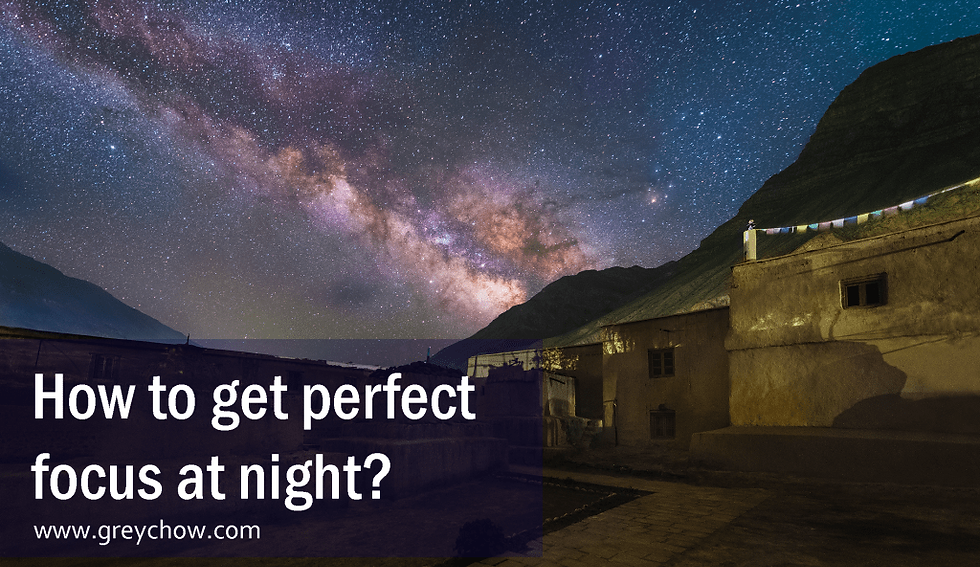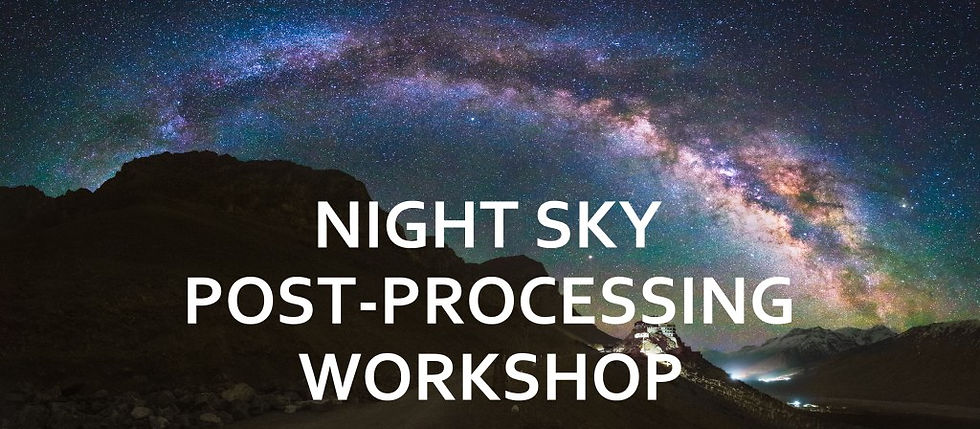How to get perfect focus at night?
- grey1217

- Feb 13, 2019
- 5 min read

If you ever tried out taking a photo of the Milky Way or Star trail at night, you will know that having a perfect focus is not easy. Unlike taking a photo in daytime, not only you have to do the focusing in the dark that you can hardly see anything but also forced to use a wider aperture that you can easily miss focus and get a blurry photo.
The photo that’s out of focus is not recoverable even with the help of post-processing. Sorry to say, these photos are considered unusable and that’s the thing you would want to avoid at all cost. So, getting a photo with correct focus is extremely important.
How are we able to get the perfect focus even in the dark? I’m going to share with you three methods of focusing that I frequently use for Night Sky Photography, together with two important tips.
Before we start, the first thing you should do is to set your camera in Manual Focus mode. Auto Focus is not going to work in such an extremely low light environment. Now, let’s start talking about the three focusing methods.
1. Using Infinity Focus
Infinity Focus means that you get every subject in your frame in focus, regardless the subject is near to you or at a far distance. Then, how are we able to achieve Infinity Focus? It is easy and so far the straightforward method that I’m sharing here, as long as your lens has a focusing scale on it. With that, you only need to turn your focusing ring and point it to the infinity mark on the scale. Then you will be able to get everything in your frame in focus, just like that!
Just point the Focusing Ring to the “8” Infinity Mark to achieve Infinity Focus.
However, there is one thing you have to TAKE NOTE when using infinity focus method. First is that pointing to the infinity focus mark on your lens may not really achieve infinity focus. I know, theoretically, it should, but for some lenses, the infinity focus mark is not precisely correct. Like my Samyang/Rokinon 24mm f1.4 lens and Tokina 11-16mm f2.8 DXII (when I was still using D5000) but that does not happen on my Nikkor 14-24mm f2.8 lens.
If your infinity focus does not give you the right result, don’t worry, what you need to do is just to finetune your focusing by slightly adjusting the focusing ring and do a few test shots until you got it right. It is a bit tricky, but once you found the REAL Infinity Focus Point of your lens for the first time, you can easily set your lens to infinity focus in future. It is always at the same location.
2. Focusing on the star
The second method you can try is to focus on the star using your camera’s Live View. (if your camera’s Live View has Exposure Simulation)
What you need to do is to turn on your camera Live View, zoom in at 100% (or as far as needed). Then, using the multi-selector button to move around the “zoom box” and look for a star that’s bright enough to be seen on your camera’s Live View.
Now, with the star showing on your screen, turning the Focusing Ring on your lens until the star is in-focus and looked sharp. Lastly, zoom out back to original size and start taking photos.
If you have a lens with “wide” aperture like f2.8, f1.8 or wider, it is able to absorb more lights and gives you a brighter view of the scene through Live View, eases you in focusing.
3. Using Flashlight
If your lens does not have a Focusing Scale for Infinity Focus and not having Exposure Simulation feature to see a star in the camera’s Live View then you can try to focus with the help of a flashlight.
You just need to light up your subject with a flashlight. No, not on the Milky Way, that’s impossible. I’m referring subjects on the ground, which can also be used as your foreground subject.
With the foreground is lightened up, now you can easily focus on the foreground.
Then, turn on your camera’s Live View, zoom in on the lighted subject, and Manual Focus on it. Same as the previous method, just turn the Focusing Ring until the subject is in focus, zoom out back to original size and start taking photos.
Still unable to get the focus right?
If you have followed exactly one of the above mentioned methods but still getting a “soft” photo, it is probably because of…
#1 You are standing too close to your subject
When you are taking photos with Aperture at f2.8 or wider, it gives you a very shallow Depth-of-field. With that, the focusing can only cover a certain distance range, even with Infinity Focus.
Image credited to Elizabeth Gray.
If your foreground subject is too close to you, you will either:
Has your foreground subject in focus but the stars are out-of-focus.
Has your foreground subject out-of-focus but the stars are in focus.
The solution is simple, just don’t get too close to your foreground subject!
By keeping a distance, now you are able to cover both foreground subject and the stars in the Depth-of-field, even at Aperture f2.8 or wider. Based on my own experience, I would say standing at around 30 feet away from your subject would be good. (Just a roughly figure, to be honest, I’m not good in measuring distance, lol)
#2 You are using a wrong Shutter Speed
You may say, Shutter Speed has nothing to do with focusing. Yes, you’re right, but you may mistakenly think that the stars on your photos appear to be blurry is because of Out-of-focus. No, it is not.
The stars are not “in-focus” or not a round shape is because they “move”. Actually, the stars don’t move but our earth does, and because of this Earth-rotation, if you are using a slow Shutter Speed, you will capture the “movement” of the stars. This is also how you able to photograph the Star trail, but for now, let’s focus on getting a clear photo of the stars.
Left photo was using 30 seconds Shutter Speed. For right photo, it was 15 seconds Shutter Speed.
To avoid getting the Star trail, you need to use a faster Shutter Speed. For that, you can use 500 Rule guideline to decide what’s the correct Shutter Speed base on the Focal Length. Basically, it is about dividing your Focal Length by 500, and the number that you get is going to be your Shutter Speed. For more details about 500 Rule, you can check out my previous article HERE, talking about how to find the camera setting to photograph Milky Way.
That’s all for this article, now you should have a better understanding on getting a perfect focus in dark. I hope you able to get some amazing photos of the Milky Way. Happy shooting! 😀
If you want to know more about how to process a photo of Milky Way, check out my workshop HERE.

Please feel free to share this post if you enjoy reading it! :)
.png)



Comments